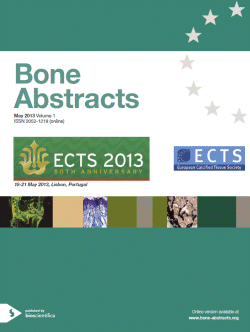
European Calcified Tissue Society Congress 2013
Lisbon,
Portugal
18 May 2013 - 22 May 2013

Poster Presentations
Chondrocytes and cartilage
ba0001pp247 | Chondrocytes and cartilage | ECTS2013
Expression of novel cartilage genes during maturation of cultured chondrocytes
Awodele Babatunde , Mirams Michiko , Pagel Charles , Mackie Eleanor
ba0001pp248 | Chondrocytes and cartilage | ECTS2013
Intracellular calcium is influenced by the nuclear magnetic resonance therapy in Cal-78 chondrosarcoma cells
Steinecker-Frohnwieser Bibiane , Weigl Lukas , Kullich Werner
ba0001pp249 | Chondrocytes and cartilage | ECTS2013
Impairment of endochondral ossification by Hoxa2 overexpression: a plausible molecular explanation of idiopathic proportionate short stature
Deprez Pierre M L , Nichane Miloud G , Lengele Benoit , Rezsohazy Rene , Nyssen-Behets Catherine
ba0001pp250 | Chondrocytes and cartilage | ECTS2013
In vitro effects of caffeine on the proliferation, apoptosis, and gene transcripts expression of chondrogenic differentiation in growth cartilage of rats
Reis Amanda Maria Sena , Raad Raquel Viana , de Melo Ocarino Natalia , Serakides Rogeria
ba0001pp251 | Chondrocytes and cartilage | ECTS2013
Endochondral bone growth of rats
Reis Amanda Maria Sena , Batista Ana Claudia Moura , de Melo ocarino Natalia , Serakides Rogeria
ba0001pp252 | Chondrocytes and cartilage | ECTS2013
Modulation of c-Myb during chondrogenesis
Oralova Veronika , Buchtova Marcela , Janeckova Eva , Tucker Abigail , Matalova Eva
ba0001pp253 | Chondrocytes and cartilage | ECTS2013
Can adrenomedullin be a potential osteoarthritis treatment?
Chatron-Colliet Aurore , Velard Frederic , Come Dominique , Lin Hilene , Ea Hang Korng , Liote Frederic
ba0001pp254 | Chondrocytes and cartilage | ECTS2013
Oxygen tension-mediated regulation of chondrogenic differentiation: application to stem cells based osteochondral repair
Portron Sophie , Hivernaud Vincent , Merceron Christophe , Lesoeur Julie , Masson Martial , Gauthier Olivier , Vinatier Claire , Beck Laurent , Guicheux Jerome
ba0001pp255 | Chondrocytes and cartilage | ECTS2013
Effects of an in vitro low-oxygen-tension preconditioning of adipose stem cells on their in vivo chondrogenic potential: application in cartilage tissue repair
Portron Sophie , Merceron Christophe , Gauthier Olivier , Lesoeur Julie , Sourice Sophie , Masson Martial , Fellah Borhane , Geffroy Olivier , Lallemand Elodie , Weiss Pierre , Guicheux Jerome , Vinatier Claire
ba0001pp256 | Chondrocytes and cartilage | ECTS2013
Sclerostin preserves chondrocyte maintenance by modulating the crosstalk between canonical and non-canonical Wnt pathways
Bouaziz Wafa , Funck-Brentano Thomas , Lin Hilene , Ea Hang-Korng , Hay Eric , Cohen-Solal Martine
ba0001pp257 | Chondrocytes and cartilage | ECTS2013
Stress-induced matrix metalloproteinase production in cartilage does not depend on NALP3-inflammasome in osteoarthritis
Bougault Carole , Gosset Marjolaine , Houard Xavier , Salvat Colette , Godmann Lars , Pap Thomas , Jacques Claire , Berenbaum Francis
ba0001pp258 | Chondrocytes and cartilage | ECTS2013
Transcription factor Nkx3.2 plays crucial role in primary chondrogenesis by up-regulating type II collagen a1 transcription activity
Ebina Kosuke , Kawato Yoshitaka , Hirao Makoto , Honjo Yui , Morimoto Tokimitsu , Hashimoto Jun , Shi Kenrin , Yoshikawa Hideki
ba0001pp259 | Chondrocytes and cartilage | ECTS2013
The influence of 2-oxoglutaric acid on articular cartilage of gastrectomised rats
Dobrowolski Piotr , Tomaszewska Ewa , Kurlak Paulina , Pierzynowski Stefan
ba0001pp260 | Chondrocytes and cartilage | ECTS2013
Dietary 2-oxoglutarate protects femoral cartilage of 9 months male pigs prenatally treated with dexamethasone
Tomaszewska Ewa , Dobrowolski Piotr , Hulas-Stasiak Monika , Kurlak Paulina
ba0001pp261 | Chondrocytes and cartilage | ECTS2013
Prenatally administered acrylamide programs a gut-bone axis of guinea pig newborns
Tomaszewska Ewa , Dobrowolski Piotr , Kurlak Paulina , Badzian Barbara , Hulas-Stasiak Monika , Puzio Iwona , Kostro Krzysztof
ba0001pp262 | Chondrocytes and cartilage | ECTS2013
Establishing an in vitro system to study chondrocyte phenotypes associated to human hereditary hemochromatosis and identify molecular players involved in chondrocyte related iron metabolism
Simao Marcio , Gavaia Paulo , Pinto Jorge , Korng Ea , Cancela M Leonor
ba0001pp263 | Chondrocytes and cartilage | ECTS2013
Inflammatory effects on knee joint tissue by indoxyl sulfate
Chen Ya-Yun , Lee Herng-Sheng , Hsu Yu-Juei
ba0001pp264 | Chondrocytes and cartilage | ECTS2013
Upregulation of GAP-43 is linked to the cartilage repair by microarray analysis
Chang Chih-Shan , Lee Herng-Sheng
ba0001pp265 | Chondrocytes and cartilage | ECTS2013
Decrypting TGFβ signaling in age-induced osteoarthritis
de Vinuesa Amaya Garcia , Blaney-Davidson Esmeralda , Sanchez-Duffhues Gonzalo , van Caam Arjan , Vitters Elly , Meulenbelt Ingrid , Goumans Marie Jose , van der Kraan Peter , ten Dijke Peter
ba0001pp266 | Chondrocytes and cartilage | ECTS2013
The Rho/ROCK GTPase pathway differentially modulates chondrocyte and osteoblast differentiation from pluripotent stem cells
Bukhary Dalea M , McDonald Fraser , Grigoriadis Agamemnon E



